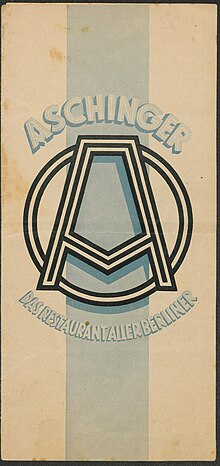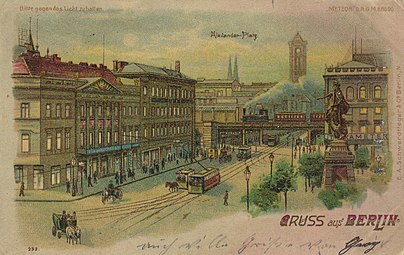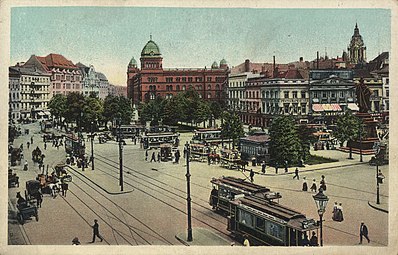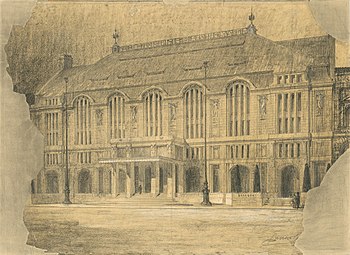Aschinger
Aschinger was a gastronomy company founded in Berlin in 1892 , which was particularly known for its large standing beer halls. The name is associated with a success story that had never occurred in this dimension in the German Empire before 1900. At times, Aschinger was Europe's largest catering company.
history
Founding and development until the 1920s
The brothers August and Carl Aschinger , who immigrated from Oberderdingen in what was then Württemberg , founded "Bierquellen" in Berlin from 1892 onwards. These were standing beer halls and later also restaurants where you could eat quickly, well and cheaply. The different types of beer were initially offered at a unit price of 10 pfennigs . The first “Bierquelle” opened on September 1, 1892 at Neue Roßstraße 4 on Köllnischer Markt by the Märkisches Museum underground station . Others followed in busy places such as Leipziger Strasse (numbers 60/61, 79, 85), Potsdamer Strasse ( Weinhaus Rheingold ) in no.3 as well as numbers 57/58 and 101/102 as well as Friedrichstrasse (numbers 79a, 97 and 191), at Rosenthaler Platz ( Rosenthaler Straße 72a), Alexanderplatz and Hackeschen and Werderschen Markt .
Aschinger soon advanced to become Europe's largest catering company with 30 "beer sources", 15 pastry shops , eight other restaurants, and 20 sales outlets. Up to 1.1 million bread rolls were baked weekly in the central Saarbrücker Strasse in the royal city .
At Aschinger, there were inexpensive meals and , if desired, rolls with the dishes, which made the name Aschinger popular relatively quickly, especially among poorer sections of the population. Aschinger's beer sausages and pea soup were particularly well-known and popular . "Best quality at the cheapest price" was the motto of the rapidly expanding company, which produced all dishes in its own central operation, thus having complete quality control . Further pastry shops and bakery outlets were added at the beginning of the 20th century. The establishment of the restaurants should by no means look poor, but rather elegant, which is why the beer springs were lavishly equipped with chandeliers , mirrors and inviting shop windows. Despite the lavish interior , they were not cozy, neither in terms of furnishings nor cleanliness. In the first half of the 20th century, the standing beer halls were considered “typical of Berlin”.
From 1905 Aschinger - meanwhile converted into a stock corporation - entered the hotel business together with the construction of the Rheingold wine house ( Potsdamer Straße 3; from 1937 No. 8) near Potsdamer Platz . The luxury hotel Fürstenhof and the palace hotel were acquired by 1913 . In the years 1924 to 1926, Aschinger AG also acquired the majority of shares in the Berliner Hotel-Gesellschaft and Hotelbetriebs AG. In addition, she took over the catering operations of the Deutschlandhalle .
Aschinger until 1945

In the 1930s, the network of Aschinger “beer springs” grew to 30 bars. These were distributed throughout Berlin's urban area.
With the Nazi regime, the company worked closely (as for example on the Reich Party Rallies Aschinger beer served). In the course of the expropriation (“ Aryanization ”) of the Kempinski Group, Aschinger also took over the Fatherland family from Kempinski.
Beer sources
The numbers correspond to the numbering of the restaurants carried out by the company. In individual cases, especially after the end of the Second World War, the facilities were obviously renumbered.
1. Neue Roßstrasse 4 / Köllnischer Fischmarkt 5
2. Leipziger Strasse 60/61
3. Friedrichstrasse 88
4. Alexanderstrasse 1/2
5. Potsdamer Strasse 101/102
6. Oranienstrasse 145/146
7. Potsdamer Strasse 57/58
8. Große Frankfurter Strasse 37
9. Rosenthaler Strasse 72 a
10. Hackescher Markt 5
11. Leipziger Strasse 80
12. Leipziger Strasse 79
13. Werderscher Markt 10
14. Friedrichstrasse 133 a
15. Kommandantenstrasse 71
16. Alexanderstrasse 21
17. Friedrichstrasse 47
18. Rathenower Strasse 1
19. Königgrätzer Strasse 116
20. Friedrichstrasse 191
21. Köpenicker Strasse 103
22. Friedrichstrasse 250 / Müllerstrasse 3 B
23. Potsdamer Strasse 22 a
24. Königstrasse 59
25. Chausseestrasse 1
26. Königgrätzer Strasse 129
27. Leipziger Strasse 9 / Friedrichstrasse 79 a
28. Potsdamer Strasse 1 a
29. Invalidenstrasse 123
30. Friedrichstrasse 97
31. Blücherplatz 2
32. Turmstrasse 73
33. Königgrätzer Strasse 29/30
34. Tauentzienstrasse 13
post war period
Since 80 percent of the Aschinger restaurants were destroyed in the Second World War , it was difficult to start over. In 1947, the German Treuhandstelle for the administration of confiscated goods from war criminals and exposed fascists took over the administrative center, which was now in the Soviet sector on Saarbrücker Strasse. The branches in the eastern part were assigned to the newly emerging HO after the expropriation .

The successor company to Aschinger AG opened its first pastry shop after the Second World War in West Berlin in 1949 near Wittenbergplatz . The company then grew back into a medium-sized company, which ceased to exist on October 1, 1976 with the closure of the last branch in the Aschinger-Haus at Joachimsthaler Straße 3, near the Zoo train station . In April 1990, with the participation of a member of the former Aschinger family, “Aschinger's Historischer Braukeller” was opened on Kurfürstendamm , which went bankrupt in 2000 and then closed again.
The restaurants later trading under the name Aschinger have no connection with the original company.
reception
- Alfred Döblin created a literary monument for the Aschinger company. A visit by the hero Franz Biberkopf to this Berlin institution is described in detail in his novel Berlin Alexanderplatz .
- Also in the book Blood Brothers. A Berlin clique novel by Ernst Haffner , in which the life of homeless youths in Berlin in the 1930s is described, Aschinger is one of a frequently mentioned institution where people could satisfy their hunger with little money.
- Volker Kutscher's crime novels are also set in the 1930s . His protagonist, Commissioner Gereon Rath, can be found several times in Aschinger on Alexanderplatz.
- Another book in which Aschinger is mentioned is Fabian. The story of a moralist by Erich Kästner . The protagonist is drinking a cup of coffee here.
- The poem by Ulrich Roski Schwoches go out to eat (1973) tells of a visit to a Chinese restaurant that ends in chaos. The last lines read: “Bad guys still have no sense of humor; drink their bottles empty / and go to Aschinger's. "
Building views
Aschinger on Alexanderplatz (left), 1900
28. Source of beer at Potsdamer Strasse 1a, around 1910
Aschinger at Friedrichstrasse 97, 1915
literature
- Keith Allen: Hungry Metropolis. Food, welfare and commerce in Berlin . Results-Verlag, Hamburg 2002, ISBN 3-87916-066-X .
- Karl-Heinz Glaser: Aschinger's beer springs conquer Berlin. From the wine town of Oberderdingen to the up-and-coming capital . regional culture publisher, Ubstadt-Weiher 2004, ISBN 3-89735-291-5 .
- Elfi splendor : M. Kempinski & Co . Nicolai, Berlin 1994, ISBN 3-87584-458-0 .
- Michael Klein: Aschinger Group - Aschinger's Aktien-Gesellschaft, Hotelbetriebs-AG, M. Kempinski & Co. Weinhaus und Handelsgesellschaft mbH. (Introduction, overview and summary). In: Landesarchiv Berlin: Find aids . Vol. 34. Stock group A Rep. 225. Berlin 34.2005 (PDF, extensive lit.-indexed; 1.5 MB).
- Michael Klein: Aschinger - not just a name, but a term! . In: Berlin in the past and present. Yearbook of the State Archives. Gebr. Mann, Berlin 2004, pp. 117-134, ISBN 3786125015 ISSN 0175-8446 .
- Hans Aschenbrenner: At Aschinger - almost like before . In: Berlin monthly journal . Edition Luisenstadt, Berlin 8.1999, 6 (online), ISSN 0944-5560 .
- Menus from 1936 and 1956 as PDF
Web links
- private side hotel operations: Kempinski and Aschinger AG
- Museum and gallery in the Aschingerhaus in Oberderdingen, in the city triangle of Stuttgart - Heilbronn - Karlsruhe (Baden-Württemberg) ( Memento from July 1, 2007 in the Internet Archive )
- Early documents and newspaper articles on Aschinger in the press kit of the 20th century of the ZBW - Leibniz Information Center for Economics .
Individual evidence
- ↑ Aschinger-Ausschänke at Potsdamer Platz
- ^ Michael Klein: Aschinger Group - Aschinger's Aktien-Gesellschaft, Hotelbetriebs-AG, M. Kempinski & Co. Weinhaus und Handelsgesellschaft mbH. (Introduction, overview and summary). In: Landesarchiv Berlin: Find aids . Bd. 34. Stock group A Rep. 225. Berlin 34.2005
- ↑ Photography 1964 : “People and a woman with buggy at a crosswalk at Berlin Zoo. In the back of the Bilka and in front of the Aschinger house. "
- ↑ Photography 1970 : “West-Berlin, Charlottenburg; Restaurant Aschinger in Joachimsthaler Strasse, on the right the Zoologischer Garten station. In front of the Aschinger is a truck from the Berliner Kindl brewery. "
- ↑ Photography 1956 : "Neon signs and advertising in West Berlin"







